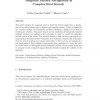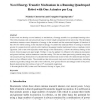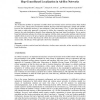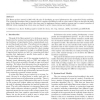ICRA
2010
IEEE
13 years 10 months ago
2010
IEEE
—This paper describes the synthesis of correct robot control from high-level tasks that include non-projective locative prepositions. Here, locative prepositions such as ‘near�...
ICRA
2010
IEEE
13 years 10 months ago
2010
IEEE
— We propose two contrasting approaches to the scalable distributed control of a swarm of self-assembling miniaturized robots, specifically the formation of chains of a desired ...
IJON
2008
13 years 10 months ago
2008
This article depicts the approach used to build the Topos application, a simulation of two-wheel robots able to discern real complex sounds. Topos is framed in the nouvelle concep...
HRI
2010
ACM
13 years 10 months ago
2010
ACM
—Robots do not have any capability of taking moral responsibility. At the same time industrial robotics is entering a new era with “intelligent” robots sharing workbench with...
AR
2010
13 years 10 months ago
2010
In this work we develop a novel method, or mechanism, of energy transfer in a quadruped running robot. The robot possesses only one actuator per leg, for lower weight and greater ...
RAS
2008
13 years 11 months ago
2008
Even the best laid plans can fail, and robot plans executed in real world domains tend to do so often. The ability of a robot to reliably monitor the execution of plans and detect...
RAS
2007
13 years 11 months ago
2007
The localization problem is important in mobile robots and wireless sensor network and has been studied for many years. Among many localization methods, the hop-count based approa...
RAS
2007
13 years 11 months ago
2007
Robots are rapidly evolving from factory work-horses to robot-companions. The future of robots, as our companions, is highly dependent on their abilities to understand, interpret ...
AROBOTS
2007
13 years 11 months ago
2007
We describe a novel method whereby a particle filter is used to create a potential field for robot control without prior clustering. We show an application of this technique to ...
AEI
2010
13 years 11 months ago
2010
The Ikaros project started in 2001 with the aim of developing an open infrastructure for system-level brain modeling. The system has developed into a general tool for cognitive mo...




